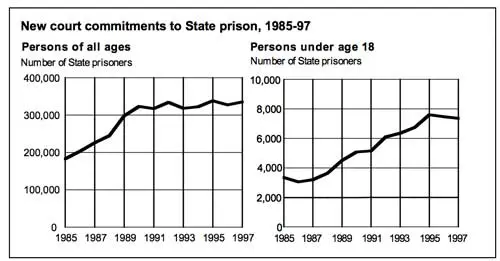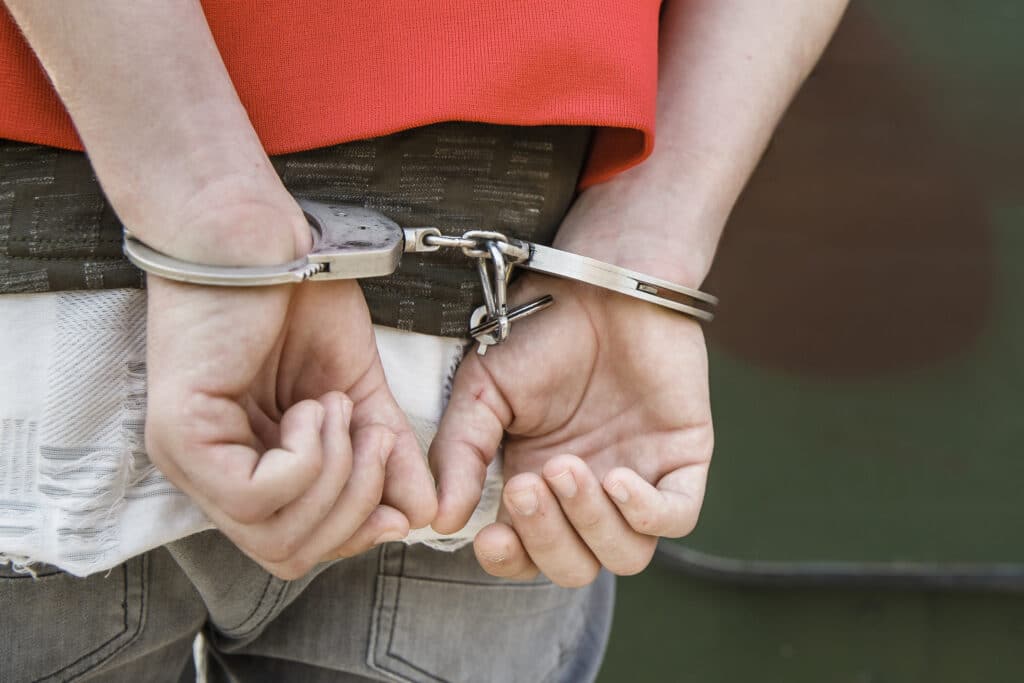The juvenile justice system was actually developed almost a century ago, in response to the atrocities juveniles were subjected to in adult jails. Unfortunately, as the system developed, and there was widespread overcrowding and lack of facilities, many juveniles were, once again, placed with adults, and subjected to assault and rape. Adult prisons and jails were simply not equipped to protect young offenders from risks, and, the question once again became, “If you lock up a 13-year old with robbers, murderers and rapists, what do you think he will become when he grows up?”
Many believe that a civilized society can be judged by the way it treats its children, and if that is so, the United States should be judged harshly. We incarcerate and execute more of our juveniles than any other country, expanding prison systems while we systematically decrease spending on preventative and alternative programs. Obviously, helping parents provide their children with proper care, and alternative activities, could go a long way toward decreasing the number of incarcerated youth. Public housing projects which have Boys and Girls Clubs show greatly decreased rates of juvenile crime and drug activity.
Why are Juveniles Ending up Behind Bars?
In addition to making an all-out effort to prevent juveniles from ending up behind bars, there is the question of why juveniles are committing crimes in the first place. Potential reasons for juvenile crimes include the increased availability of firearms, the fact that there
are more and more families attempting to survive on poverty-level incomes, the number of juveniles with a history of physical or sexual abuse, and the number of children who suffered neurological damage due to prenatal exposure to alcohol. While you might not think the last reason would be all that common, it actually occurs more often than you would think. One out of every hundred children is born with sufficient brain damage from prenatal alcohol exposure to result in problems which will interfere with the child’s ability to function in the world. Attention deficits, memory deficits, poor impulse control, poor judgment, hyperactivity and difficulties processing thoughts are common among children exposed to alcohol in the womb. Further, consider the fact that among children who suffer from Fetal Alcohol Syndrome, there is a 60 percent increased risk of those children being charged or convicted of a crime.

Request a Free Consultation
What Determines Whether Juveniles Will Be Charged as Adults?
Of course we want to believe that juveniles are only tried as adults in the most egregious of cases. Unfortunately, this is far from true. In the United States there are nine states which automatically charge seventeen-year-olds as adults.
Nine states automatically charge 17 year olds as adults
This, despite the fact that 2013 research showed at least half of those juveniles sent to adult court had committed a relatively minor crime rather than a violent criminal offense. The determination of whether a juvenile should be charged as an adult is most often left to prosecutors and judges, who may have their own set of biases related to parental history, economic class and race—none of which have much to do with the actual safety of the public.
Human Rights Activist Seeks to End Sexual Violence Against Juveniles Behind Bars
An excerpt taken from a book written by T.J.Parsel, a human rights activist, who is dedicated to ending sexual violence against juveniles in detention, gives a disturbing glimpse into the world of incarcerated juveniles. Parsel testified on Capitol Hill with a mother from Texas whose 17-year old son was sentenced to prison after setting a garbage can on fire. While in prison, the boy was repeatedly raped, and later hanged himself with a bedsheet inside his cell.
As horrific as this story is, Parsel writes that this story is actually much more common than any of us want to believe. Parsel feels a particular bond with juveniles behind bars, as many years ago he was one of them. Parsel was also sent to prison at the age of 17, for robbing a photo shop with a toy gun. Parsel writes that on his first day in prison he was “drugged, gang-raped and turned into a sexual chattel.”
Parsel believes that what happened to him, and what happened to the seventeen-year-old from Texas, are not out of the ordinary for juveniles who find themselves locked behind bars. In fact, in findings set forth in the Prison Rape Elimination Act of 2003, the research found that juveniles were five times as likely to be sexually assaulted when they were placed in an adult facility rather than a juvenile facility. Reports by youth advocacy groups find that juveniles housed in adult facilities are 36 times more likely to commit suicide.
Parsel notes that while most juveniles who serve time are eventually released, they carry trauma from sexual assault with them or they react to the world with violence as a result of constantly fending off sexual assaults. Although the Prison Rape Elimination Act of 2003 did, to some extent, prevent juveniles from sharing cells with adult inmates, there are still scores of problems associated with the juvenile justice system. Despite the fact that the Prison Rape Elimination Act stipulated juveniles were not to be held within “sight and sound” of adult inmates, by 2015, only ten states were in full compliance.
Children Tried as Adults and Sentenced to Adult Prisons
Nearly twenty years ago, Christopher Kellerman wrote “Children Behind Bars,” detailing the outcomes of children who were tried as adults—and sentenced to adult punishments. Kellerman noted that more than 750,000 juvenile delinquency cases are heard by judges across the U.S. each year, with “tens of thousands” tried as adults. In 2013, fifteen years later, more than 250,000 juveniles are tried as adults each year—and given adult sentences where they serve prison time with adults. The United States is one of the few countries that provides for execution for crimes committed by juveniles—and one of the very few who have actually carried out those executions.
Over the past decade, the number of juvenile cases referred to adult courts has increased by more than 70 percent—a truly alarming statistic. Many states have consistently lowered the age children can be tried as adults, and, in some states, this age is as young as ten years old. While these children will almost certainly face unspeakable conditions while in prison, perhaps equally alarming are the number of juveniles serving time for very minor offenses—and what happens to those juveniles while they serve their time in a jail or a juvenile facility.
Juveniles Serving Time for Minor Offenses
Far too often, juveniles are placed behind bars for offenses that are not even criminal acts. As an example, there are close to 7,000 juveniles behind bars for “technical violations” of their probation requirements, and more than 600 juveniles are behind bars for status offenses—noncriminal acts considered violations only because the person is a minor. Typical status offenses include running away from home, violating curfew, underage use of alcohol, and truancy. In fact, juveniles commit only about 10 percent of the nation’s violent crimes—the vast majority are for status offenses. Consider the following:
- Juvenile arrests actually dropped 7 percent between 1999 and 2008.
- In 2008, 56 percent of all juvenile delinquency cases were handled formally, while 44 percent were handled informally.
- Among those cases handled informally, nearly half were dismissed, often for lack of legal basis.
- In the remaining cases which were handled informally, 58 percent of the juveniles voluntarily agreed to be referred to a social service agency, informal probation or the payment of fines or other type of voluntary restitution.
- Sixty-one percent of formally processed delinquency cases resulted in a guilty verdict.
- Among those judged “guilty,” about 28 percent were placed in a facility.
- On any given day, more than 70,000 juvenile offenders are being held in a juvenile detention facility, a correction facility, a group home, or a shelter.
- Two-thirds of juveniles held in a detention or correction facility are there for a non-violent charge (property offenses, drug offenses, probation violations or status offenses).
- At least one-fourth of juvenile detention centers are over capacity.
Considering those 70,000 or more offenders who are being held in some type of facility, the following statistics are particularly alarming:
- More than one in ten youth in state juvenile facilities, as well as non-state facilities, reported one or more incidents of sexual victimization by the staff of another youth since admission to the facility.
- Across the nation, on any given night, some 10,000 juveniles are being held in an adult jail or prison, although state laws vary widely concerning whether juveniles can be legally housed in an adult facility;
- Most juveniles are denied the type of educational and rehabilitative services necessary for their development while housed in an adult facility.
- More importantly, youth are considered to be in extreme danger when held in adult facilities.
- Often, juveniles are placed in isolation, in an attempt to protect them, however, such isolation can lead to equally harmful consequences, including death.

Source: Bureau of Justice Statistics
Fighting The Frightening Statistics of Juveniles Behind Bars
The New Republic published an expose on prisons in which a prison guard stated that a young inmate’s chances of avoiding rape are almost zero while incarcerated. Juveniles not only face the greatest chance of being sexually attacked, they are also much more likely to be beaten by staff and attacked with a weapon. Any way you look at it, incarceration for juveniles is extremely traumatic and dangerous, and studies have consistently shown that juveniles who are victims of violence are more likely to exhibit violence to others, in particular, aggression towards women and children.
Because the brains of juveniles are still developing, their patterns of behavior are far from being “fixed.” This means juveniles have a much better chance of rehabilitation than adults. Unfortunately, this potential is lost in prisons and jails, most of which see no distinction between adults and juveniles. Scientific research shows that when juveniles suffer from traumatic, extremely stressful situations, the results can be permanent damage to both physical and mental well-being.
A CDC study concluded that juveniles who were subjected to multiple incidences and types of trauma (physical and sexual abuse), were expected to have a lifespan on average of 20 years less than their peers who suffered no such trauma. Juveniles who are incarcerated are routinely punished for exhibiting typical teenage behaviors. These juveniles may truly not fully understand the prison or jail rules, and may have no idea how to cope with their anxiety.
Less Severe Alternatives to Juvenile Incarceration Work
There are less severe alternatives to incarcerating juveniles—and they work. Diversion programs, drug treatments, family programs, community-based programs and treatment clinics have been found to have much better results than incarceration. Juveniles placed in these alternative programs are much less likely to re-offend than those who are put behind bars. These programs are less costly to the public in addition to being successful.
Placing young people in juvenile detention facilities can cost the public as much as $65,000 per year. Alternatives to incarceration not only reduce crime but saves money. In fact, research shows that every dollar spent on alternative programs for juveniles results in $13 in savings. Plus, early interventions for juveniles can effectively prevent those considered “high-risk” from re-offending, saving the public millions of dollars.
Changing the treatment of juveniles in prison, and convincing lawmakers that alternative treatments and preventative measures are more effective than prison requires changing our culture. When New York City officials issued updated policies for the treatment of juveniles sent to Riker’s Island, seventy-five officers resisted those reforms and had to be transferred to other jobs. A news report by Soledad O’Brien detailed a once-notorious juvenile lockup in Las Cruces, NM. The J. Paul Taylor Center is trying something new for juvenile offenders—education, counseling, and a second chance. The program is modeled after a similar one in Missouri which resulted in one of the lowest recidivism rates in the country. Every state in the U.S. should take a look at those results and consider similar programs.

